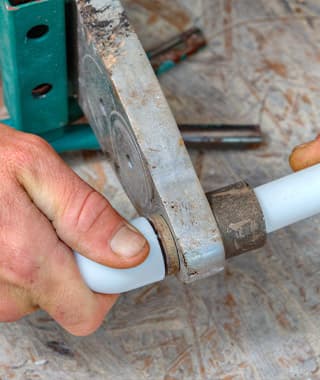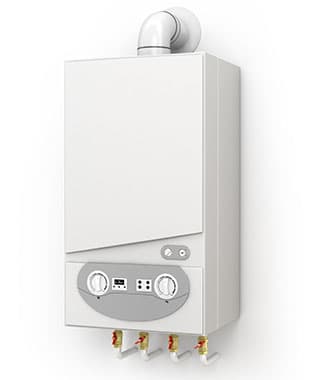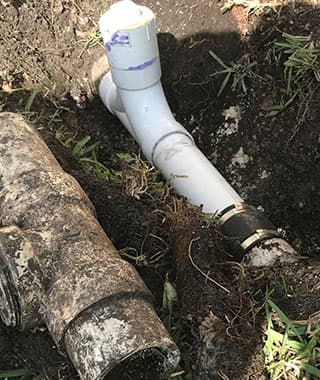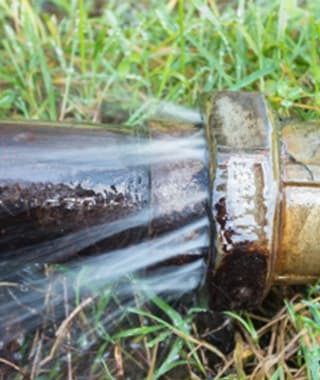If your home was built before 1975, chances are your plumbing system consists of cast iron pipes. Sewer camera inspections we perform reveal that 8 out of 10 will have to be replaced. The reason being most of the cast iron are currently past their average lifespans.
The project duration can depend on the company you choose to go with. For example, if you choose a licensed company with manpower like a dedicated plumbing crew working around the clock, Draft its own plans, permit runners, dedicated project managers, tile Installers and years of experience it can shorten the time frame drastically. We understand the sense of urgency to get back to a normal life so we have focused on our 40+ year old proven process to cut time wherever we can. We figured out it has to do with our divide and conquer techniques. Rome wasn’t built in a day but the more skilled people working towards the goal will speed up the process. A typical cast Iron project can depend on how many plumbing outlets there are and how involved the project is. The city where you live in can also delay things as process times may vary city to city. A regular 3 bedroom, 2 bathroom home, with kitchen and laundry, the replacement section only of the cast iron to PVC can be done in as little as 2 weeks.
A typical cast iron project can be done in as little as 2 weeks. However this is all dependent on the city you live in and how many rooms in your home.
-
The “Spot Repair”
The “spot repair” is defined as replacing a small section of cast iron pipe inside a crawl space or slab with PVC pipe. Most of the time these repairs involve breaking a small section of flooring and replacing the worst sections of cast iron with PVC pipe. Although this route is sometimes a few thousand dollars cheaper upfront, cutting your floor, performing a spot repair on a section of cast iron pipe is probably the worst thing you can do. This should only be performed as a temporary solution to alleviate a backed up line that has completely collapsed. When the deteriorated pipe is cut for this type of temporary repair, the vibrations through the cast iron will further compromise the pipe and cause additional damage and more problems in the near future. This will usually involve spending twice as much when you have do redo all the work a second time around when the rest of the pipe goes bad. We have seen this many times where the bathroom was remodeled and a few years later and the rest of the pipe has gone bad. We have to break the floor again or it gets water damaged due to a huge backup. This is probably a property owner’s worst nightmare. -
The “PVC Liner”
There are very few plumbing companies offering this method and there is a reason why. The reason why might be that the disadvantages outweigh the advantages for the property owner. One big problem is this most cities are only allowing this as a repair and not a permanent fix. Meaning you can use it only for a section of pipe, not for the whole building drain. This also causes issues with the building drain not being to code to begin with. Some of the old cast iron piping diameters are too small and have to be replaced entirely to bring the property up to the new code requirements. To add insult to injury, the liner reduces the diameter of the pipe when installed, causing more problems in the future. Another problem is that the liner doesn’t turn during installation. This means the floor and walls will still need to be opened to replace fittings and branches. Although this is a great deal for the plumber because the job is done much faster and the property owner may pay a little less, this might not be the best option for most people. -
The “Reroute”
The best ways to fix a broken cast iron pipe is to abandon the cast iron pipe completely. There are a number of advantages to abandoning the pipe and rerouting through the exterior of the home. For one, you save on ripping most of your floors up. The building drains’ new location will be on the exterior of the home so if anything goes wrong in the future it will be easier to repair, and all your piping will be brand new PVC that will last you a lifetime. This will also add a huge upside if you ever sell the house. Unfortunately, although this is the preferred option it can’t always be done for several reasons. Some common reasons it can’t be done is that there is a pool or other structure that in the way, the distances are too long for the pipe and the pitch will be off, or the locations (bathroom, kitchen, laundry etc.) are not abutting on the exterior walls of the building. -
Replace Cast Iron Pipes in Existing Locations
If you don’t have a crawl space and you can’t do the reroute option then your next best choice is to replace the cast iron pipes in the existing locations. This will involve cutting the floor and removing the entire cast iron pipe where it currently runs under the floor and replacing it to PVC which will last more than a lifetime. Although this may turn into a huge project in your home or office the key is to find a licensed company that has been doing this type of work for a while. The common issues that most homeowners and business owners encounter when doing this type of project is length of the project, plumbing knowledge, communication, plans and permitting. The biggest benefit is at the end you will have a remodeled home and most importantly a piece of mind.
Although having your cast iron piping replaced can be a costly project, it will provide a long term solution for your plumbing issues. Replacements can range anywhere from $2000 in small sections to $50,000 for large commercial replacements.
Depending on what the project entails determines if you can stay at the property or not. When the project involves demolition of the majority of your home it might be hard to be home while the project is ongoing.









